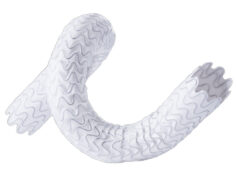 New data presented for the first time at LINC 2021 (The Leipzig Interventional Course; 25–29 January, online) support the use of drug-coated balloons (DCBs) as a treatment for dysfunctional arteriovenous fistulas (AVFs). The audience also heard the case for percutaneously-created AVFs with the Ellipsys vascular access system (Medtronic).
New data presented for the first time at LINC 2021 (The Leipzig Interventional Course; 25–29 January, online) support the use of drug-coated balloons (DCBs) as a treatment for dysfunctional arteriovenous fistulas (AVFs). The audience also heard the case for percutaneously-created AVFs with the Ellipsys vascular access system (Medtronic).
One-year results from the IN.PACT AV Access study demonstrate superior target lesion primary patency outcomes for drug-coated balloon (DCB) angioplasty compared to percutaneous transluminal angioplasty (PTA) for the treatment of de novo or restenotic obstructive lesions of native AVFs in the upper extremity. So said Andrew Holden (Auckland Hospital, Auckland, New Zealand), addressing attendees virtually.
In a comparison of surgical and percutaneous AVF creation, Robert Shahverdyan (Asklepios Clinic Barmbek, Hamburg, Germany) told LINC 2021 attendees that whilst surgically-created AVFs have a higher primary patency and fewer reinterventions, fistulas created by percutenous means with the Ellipsys vascular access system have a higher technical success rate, faster procedure times, higher assisted, secondary patency and maturation rates, faster cannulation times, and fewer abandonments.
Superior target lesion primary patency at 12 months with the IN.PACT AV DCB versus standard angioplasty, new data show
In addition to Holden, Robert Lookstein (Ichan School of Medicine at Mount Sinai, New York, USA) and Hiroaki Haruguchi (Haruguchi Vascular Access Clinic, Tokyo, Japan) are principal investigators of the IN.PACT AV Access investigational device exemption (IDE) study, which evaluated the IN.PACT AV DCB (Medtronic) versus PTA.
They conducted a global, prospective, 29-centre, 1:1 randomised, single-blinded study evaluating the safety and effectiveness of DCB angioplasty versus PTA in dysfunctional AVF, following 330 patients out to five years. Each patient enrolled in the study had lesions up to 10cm in length in the native AVF.
The primary safety outcome was measured by the serious adverse event rate involving the AVF access within 30 days of the procedure. The primary effectiveness outcome was defined as freedom from clinically-driven target lesion revascularisation (CD-TLR) or access circuit thrombosis, measured through six months post-procedure.
One year after intervention, target lesion primary patency was 65.3% in the DCB group, and 46.3% in the standard PTA group (p<0.001). Access circuit primary patency was also higher amongst the IN.PACT AV DCB cohort: 55.1% versus 35% (p<0.001).
The subset outcomes of the IN.PACT AV Access trial through 12-months were presented for the first time. Assessing the 12-month data by lesion type, Holden informed the virtual LINC audience that the IN.PACT AV DCB arm demonstrated superior patency in both de novo and restenotic lesions compared to the standard PTA arm. Target lesion primary patency was achieved in 77.5% of de novo lesions treated with the IN.PACT AV DCB (31 of 40), compared to in 61.9% of de novo lesions treated with standard PTA (26 of 42); confidence interval (CI), -4–35.2%. In restenotic lesions, target lesion primary patency was also higher in the DCB group than the standard angioplasty one: 58.4% (59 of 101) versus 35.7% (35 of 98); CI, 9.2–36.2%
Looking at the data by type of AVF type, the IN.PACT AV DCB group achieved better target lesion primary patency at 12-months for all subgroups: radiocephalic (64.5% vs. 47.2%; CI, 1.5–33%), brachiocephalic (63.8% vs. 41.2%; CI, 3.4–41.9%), and brachiobasilic (61.5% vs. 45.4%; CI, -23.5–55.6%). Commenting on these results, Holden told delegates: “Fewer reinterventions are needed to maintain target lesion primary patency in the DCB group compared to the PTA group. We saw a 56% reduction in reinterventions at six months, and a 35.4% reduction in reinterventions at 12 months.
“Through 12 months, sustained superior target lesion primary patency was achieved with DCB in restenotic lesions, and both forearm and upper arm AVF types. Subset analysis of lesion location showed a patency advantage for INPACT AV DCB over standard PTA for all lesion locations in the access circuit but particularly at the arterial inflow, anastomosis and cephalic arch.”
One-year data consistent with positive six-month results
These 12-month data concur with the six-month results of the IN.PACT AV Access study, published in The New England Journal of Medicine (NEJM) in August 2020, which also showed that DCB angioplasty is superior to standard angioplasty for the treatment of stenotic lesions in dysfunctional haemodialysis AVFs. Furthermore, it was found to be non-inferior with respect to access circuit-related serious adverse events within 30 days.
The investigators noted last summer that long-term outcomes for standard PTA—the current recommended treatment for dysfunctional haemodialysis fistulas—are poor. They suggested that DCBs delivering the antirestonotic agent paclitaxel may improve outcomes, as evidenced in the present study.
Speaking to Vascular News at the time, Lookstein commented on the clinical implications of the study: “We now have Level 1 evidence of a simple technology that is proven to be safe and effective at improving outcomes for patients with end-stage renal disease [ESKD] on haemodialysis.
“This is the first US Food and Drug Administration [FDA]-approved paclitaxel-based device since the controversy last year, which is a testament not only to the incredible results seen in this trial, but also the significant needs of this population.”
Percutaneous AVF creation with Ellipsys faster, and “easier to salvage” than surgically-created AVFs
In a comparison of surgical and percutaneous AVF creation, Shahverdyan told LINC 2021 attendees that whilst surgical AVFs have a higher primary patency and fewer re-interventions, percutaneous AVFs with the Ellipsys vascular access system (Medtronic) have a higher technical success rate, faster procedure times, higher assisted, secondary patency and maturation rates, faster cannulation times, and fewer abandonments.
There are currently two systems available on the market that allow for AVFs to be created percutaneously: the Ellipsys vascular access system and the WavelinQ 4F endoAVF system from BD.
Comparing these two endovascular AVF options with the surgical Gracz technique, the investigators have created over 500 new vascular accesses during the study period in total, from which Ellipsys was used in 116 patients, WavelinQ 4F in 41 patients, and Gracz surgical AVF creation was performed in 90 patients.
Technical success was 100% in the Ellipsys and surgical Gracz groups, and 92.7% in the WavelinQ group.
“Anastomosis is very important,” Shahverdyan said, before sharing that 100% of anastomoses were radial in the Ellipsys group, while 61% were radial in the WavelinQ groups (a further 34.1% were ulnar), and 37% were radial in the Gracz group (an additional 12% were ulnar, and 51% were brachial). Commenting on the fact that half of surgical AVFs were brachial, Shahverdyan noted: “Anastomosis [location] is not only important for the flow, but also after a failed endoAVF, you could still create a brachial artery based anastomosis [surgically]”.
The procedure time was significantly shorter when using the Ellipsys, with a median time of 13 minutes versus 62 minutes in the WavelinQ arm and 69 minutes in the Gracz arm.
“This is where it gets interesting,” Shahverdyan enthused. He shared that maturation at four weeks “is similarly high for Ellipsys and Gracz” (78.4% and 80%, respectively), and that they observed total maturation in 88% of patients for both these groups. Time to cannulation in dialysis patients was shorter for Ellipsys procedures (52 days vs. 69 days in the surgical cohort), and, although there were more interventions in the endoAVF groups, fewer Ellipsys AVFs were abandoned or converted to another fistula (12.3% vs. 36.6% in the WavelinQ group and 15.6% in the surgical group).
At six months, one year, and two years, primary patency was highest in the surgical Gracz group (68%, 53%, and 42%, respectively). The Ellipsys had the second highest primary patency at all time points (50%, 34%, and 27%, respectively), whilst primary patency with WavelinQ was lowest (35%, 27%, and 23%, respectively). However, assisted patency rates at six months, one year, and two years were similarly high for Ellipsys (83%, 77%, and 77%, respectively) and Gracz (84%, 80%, and 78%, respectively) groups, and secondary patency rates were slightly, but not significantly, higher for Ellipsys-group (89%, 87% and 87%) versus Gracz-group (855, 82% and 82%).
“To conclude,” Shahverdyan said, “Ellipsys demonstrates high technical success and faster procedural times compared with both surgical and WavelinQ procedures. It shows similarly high assisted and secondary patency and maturation rates as the Gracz fistula, and especially if you compare it to the proximal radial artery based Gracz AVF, it shows significantly higher secondary patency rates. There are fast cannulation times for Ellipsys AVF, and although there are fewer re-interventions for the Gracz AVF [than with Ellipsys], there are fewer abandonments for Ellipsys percutaneous AVF, so it is easier to salvage.
“Therefore, Ellipsys percutaneous AVF expands the options for a valid, long-term AVF creation in our patients.”











